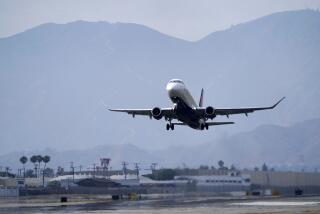Safety Board Says Laser Beam Caused Skywest Incident, Warns of Danger
- Share via
WASHINGTON — A laser beam, apparently from a light show at a Los Angeles hotel, temporarily blinded the pilot of a Skywest propjet in November, prompting the National Transportation Safety Board on Wednesday to warn that such lasers pose an increasing safety risk to aviation.
In the Skywest incident, the pilot was scanning the sky for other air traffic when he was hit in the eye by a laser beam that safety investigators later determined probably came from an area just south of downtown Los Angeles, the safety board reported in a letter to the Federal Aviation Administration.
For the record:
12:00 a.m. March 1, 1997 For the Record
Los Angeles Times Saturday March 1, 1997 Home Edition Business Part D Page 3 Financial Desk 2 inches; 56 words Type of Material: Correction
Laser Beam--The Times incorrectly reported Thursday that a National Transportation Safety Board report indicated that a light show at a Los Angeles hotel was the probable source of a laser beam that temporarily blinded a Skywest pilot in November. In fact, it is not known where the laser light came from. The reference in the report to a hotel laser show related to a different incident in Las Vegas.
Although the FAA has been investigating reports of laser strikes on aircraft, the safety board recommendation indicates that the agency is not taking the issue seriously enough and advises that it step up research on the problem.
The FAA has been studying whether existing guidelines on the amount of power that can damage an eye are too high, but the safety board said that investigation needs to be hastened. In addition, the safety board wants to see the FAA routinely supply information to pilots warning of laser danger spots around the nation.
Gary Mucho, Los Angeles regional director of the safety board, said that potentially hundreds of incidents of laser strikes have occurred across the country, though information about them is sketchy.
“The potential is very, very serious,” Mucho said.
Outdoor laser displays are becoming increasingly common in urban America, representing a technological progression from flashing bulbs and neon tubes.
The Food and Drug Administration, which regulates laser technology, issued an order in 1995 stopping all outdoor laser shows within 20 miles of Las Vegas McCarran International Airport after more than 50 incidents were reported there in a two-year period.
The incidents included one in which a Southwest Airlines pilot was incapacitated while flying over Las Vegas after taking off from McCarran airport and was unable to focus his vision for two hours.
After that incident, the FDA issued guidelines that require laser light show impresarios to notify and obtain concurrence from the FAA whenever their displays are in close proximity to a commercial airport, Mucho said.
It is not clear whether such clearance was obtained in the Los Angeles Skywest incident, which has not been previously disclosed publicly.
The incident occurred during darkness at 6:50 p.m. on Nov. 29 and involved a flight from Bakersfield to Los Angeles. The plane, an Embraer EMB-120, was flying at about 6,000 feet--more than a mile above the Los Angeles Basin.
As the pilot was scanning the sky for other air traffic, the laser beam hit him in the right eye, causing a burning and tearing sensation, according to the safety board letter.
The pilot was incapacitated and was forced to hand over control of the aircraft to the first officer as it approached Los Angeles International Airport for a landing.
Safety board investigators used a radar track for the Skywest propjet to determine where the laser beam originated when it blinded the pilot, Mucho said. The best estimate was that the beam came from an area around the Los Angeles Memorial Coliseum, though it may have come from the downtown area, Mucho said.
The pilot did not suffer any permanent injuries and has resumed flying. None of the passengers reported any problems and no damage was sustained by the aircraft.
The safety board letter said it could not be determined whether the laser beam power level in the incident complied with FDA standards. Those standards (an exposure limit of 2.6 milliwatts per square centimeter) are under reconsideration.
The Air Force’s Armstrong Laboratory is currently investigating whether existing limits are low enough to prevent permanent damage. An FAA plan to use a simulator to study the standards has been repeatedly delayed, the safety board said.
In its recommendations, the safety board advised that the FAA complete the simulator study and revise its standards. It also suggested making all of its regulators who approve laser beam usage near airports aware of laser beam characteristics.
It also told the FAA to include information about identifying and locating lasers in its Aeronautical Information Manual, a regularly updated publication that advises pilots of various hazards and conditions around the nation.
More to Read
Sign up for Essential California
The most important California stories and recommendations in your inbox every morning.
You may occasionally receive promotional content from the Los Angeles Times.














